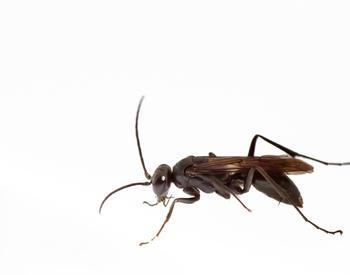Biography
Research Interests:
My research interests would be stream ecology, aquatic invertebrate biology, restoration effectiveness monitoring, stream food webs, stream and riparian linkages.
Specialty:
Aquatic Entomology
Degrees:
- Ph.D. - 1997 - Biology, University of Kentucky, Lexington
- M.S.- 1990 - Biology, Kansas State University, Manhattan, Kansas
- B.S. - 1988 - Biology, University of Nevada, Reno
Organizations and Affiliations:
- Ecological Society of America
- Society for Wetland Scientists
- American Society of Mammalogists
- North American Benthological Society
Publications
- DeBano, S.J., D.E. Wooster, J. Walker, L. McMullen, and D. Horneck. 2016. Interactive influences of climate change and agriculture on aquatic habitat in a Pacific Northwestern watershed. Ecosphere 7(6):e01357.10.1002/ecs2.1357.
- Wooster, D.E., S. W. Miller, and S.J. DeBano. 2016. Impact of season-long water abstraction on invertebrate drift. Hydrobiologia 772(1): 15-30.
- Wooster, D., J.L. Snyder, and A. Madsen. 2012. Environmental correlates of signal crayfish Pacifastacus leniusculus (Dana, 1852), density and size at two spatial scales in its native range. Journal of Crustacean Biology 32(5):741-752.
- Wooster, D.E., Miller, S.W, and S.J DeBano. 2012. An examination of the impact of multiple disturbances on a river system: taxonomic metrics versus biological traits. River Research and Applications 28(10): 1630-1643.
- Brown, P., Wooster, D.E., Johnson, S. and S.J. DeBano. 2012. Effects of water withdrawals on macroinvertebrate emergence: unexpected results for three holometabolous species. River Research and Applications 28(3): 347-358.
- Miller, S.W., D. Wooster, and J. Li. 2012. Developmental, size structure and population biomass responses of a river dwelling caddisfly (Brachycentrus occidentalis) to irrigation water withdrawals. Hydrobiologia 679: 187-203.
- Wooster, D.E., DeBano, S.J., and A. Madsen. 2011. Impact of conspecifics, predators, and temperature on the microdistribution and behavior of a detritivorous stonefly. Fundamental and Applied Limnology 179(3) 215-223.
- Scherr, M., D. Wooster, and S. Rao. 2011. Interactions between macroinvertebrate taxa and complexenvironmental gradients influencing abundance and distribution in the Umatilla River, northeastern Oregon. Journal of Aquatic Ecology 26: 255-266
- Doğramacı, M., DeBano, S.J., Kimoto, C. and D.E. Wooster. 2011. A back pack mounted suction apparatus for collecting arthropods from various habitats and vegetation. Entomologia Experimentalis et Applicata 139(1): 86-90.
- Scherr, M., D. Wooster, and S. Rao. 2010. Effects of temperature on growth rates, development and behavior of Epeorus albertae nymphs. Environmental Entomology 39: 2017-2024.
- Doğramacı, M., DeBano, S.J., Wooster, D.E. and C. Kimoto. 2010. A method for subsampling terrestrial invertebrate samples in the laboratory: Estimating abundance and taxa richness. Journal of Insect Science10:25, 17pp., available on-line at insectscience.org/10.25
- Miller, S.W., D. Wooster, and J. Li. 2010. Does species trait composition influence macroinvertebrate responses to irrigation water withdrawals: evidence from the Intermountain West, U.S.A. River Research and Application 26(10): 1261-1280
- Doğramaci, M., DeBano, S.J., Wooster, D.E. and C. Kimoto. 2009. A laboratory technique to speed processing of samples with large numbers of invertebrates. Entomologia Experimentalis et Applicata 133(3) 217-222.
- Miller, S.W., D. Wooster, and J. Li. 2007. Resistance and resilience of macroinvertebrates to irrigation water withdrawals. Freshwater Biology, 52: 2494-2510.
- Wooster, D.E. and S.J. DeBano. 2006. Impact of woody riparian patches on stream invertebrate communities. Archiv für Hydrobiologie 165(2): 241-268.
- Silver, P., D. Wooster, and M.A. Palmer. 2004. Chironomid responses to spatially structured, dynamic, streambed landscapes. Journal of the North American Benthological society, 23:69-77.
- Silver, P., C.E. Brown, and D. Wooster. 2004. Habitat partitioning by chironomid larvae in arrays of leaf patches in streams. Journal of the North American Benthological Society 23:69-77.
- Wooster, D. 1998. Amphipod (Gammarus minus) responses to predators and predator impact on amphipod density. Oecologia, 115:253-259.
- Sih, A., G. Englund, and D. Wooster. 1998. Emergent impacts of multiple predators on prey. Trends in Ecology and Evolution, 13:350-355.
- Wooster, D. and A. Sih. 1995. A review of the drift and activity responses of stream prey to predator presense. Oikos, 73:3-8.
- Arnqvist, G. and D. Wooster. 1995. Meta-analysis: synthesizing research findings in ecology and evolution. Trends in Ecology and Evolution, 10:236-240.
- Arnqvist, G. and D. Wooster. 1995. Reply from G. Arnqvist and D. Wooster. Trends in Ecology and Evolution, 10:460-461.
- Wooster, D. 1994. Predator impacts on stream benthic prey. Oecologia, 99:7-15.
- Sih, A. and D. Wooster. 1994. Prey behavior, prey dispersal and predator impacts on stream prey. Ecology, 75:1199-1207.
- Post, D.W., O.J. Reichman, and D. Wooster. 1993. Characteristics and significance of the caches of eastern woodrats (Neotoma floridana). Journal of Mammalogy 74: 688-692.
Published Datasets:
- DeBano, S.J., D.E. Wooster, J. Walker, L. McMullen, and D. Horneck. 2016. Data from: Interactive influences of climate change and agriculture on aquatic habitat in a Pacific Northwestern watershed. Dryad Digital Repository http://dx.doi.org/10.5061/dryad.564q7

